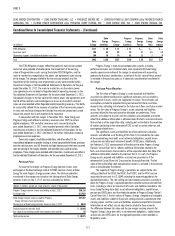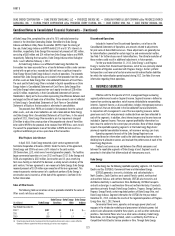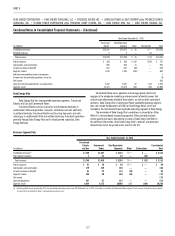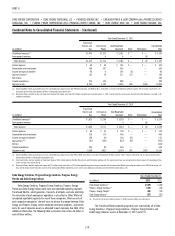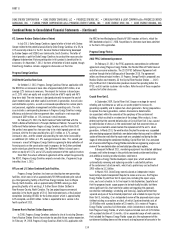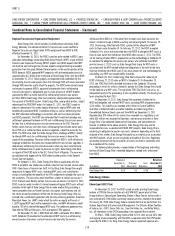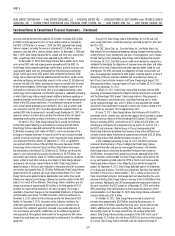Duke Energy 2012 Annual Report Download - page 151
Download and view the complete annual report
Please find page 151 of the 2012 Duke Energy annual report below. You can navigate through the pages in the report by either clicking on the pages listed below, or by using the keyword search tool below to find specific information within the annual report.
131
PART II
Combined Notes to Consolidated Financial Statements – (Continued)
DUKE ENERGY CORPORATION • DUKE ENERGY CAROLINAS, LLC • PROGRESS ENERGY, INC. • CAROLINA POWER & LIGHT COMPANY d/b/a PROGRESS ENERGY
CAROLINAS, INC. • FLORIDA POWER CORPORATION d/b/a PROGRESS ENERY FLORIDA, INC. • DUKE ENERGY OHIO, INC. • DUKE ENERGY INDIANA, INC.
As of December 31, 2011
(in millions) Duke Energy
Duke Energy
Carolinas
Progress
Energy
Progress
Energy
Carolinas
Progress
Energy
Florida
Duke
Energy
Ohio
Duke
Energy
Indiana
Regulatory Liabilities
DSM costs/Energy effi ciency $ 41 $ 41 $ 19 $ — $ 19 $ — $ —
Nuclear deferral — — 15 — 15 — —
Other 46 21 14 2 12 22 3
Total Current Regulatory Liabilities(b) 87 62 48 2 46 22 3
Removal costs 2,586 1,770 2,240 1,529 550 230 590
Accrued pension and post-retirement benefi ts 117 — — — — 19 70
Amount to be refunded to customers — — 288 — 288 — —
Storm reserve — — 135 — 135 — —
Other 216 158 64 14 51 24 23
Total Non-Current Regulatory Liabilities 2,919 1,928 2,727 1,543 1,024 273 683
Total Regulatory Liabilities $3,006 $1,990 $2,775 $1,545 $1,070 $295 $686
(a) Included in Other within Current Assets on the Consolidated Balance Sheets.
(b) Included in Other within Current Liabilities on the Consolidated Balance Sheets.
Descriptions of the regulatory assets and liabilities summarized in the
tables above, as well as their recovery and amortization periods are as follows.
Items are excluded from rate base unless otherwise noted.
Vacation accrual. Vacation is accrued as it is earned by employees and
generally recovered as it is paid, generally within one year. This includes both
accrued vacation and personal holiday pay.
Nuclear deferral. In 2009, pursuant to the FPSC nuclear cost-recovery
rule, Progress Energy Florida fi led a petition to recover costs, which primarily
consisted of preconstruction and carrying costs incurred or anticipated to be
incurred during 2009 and the projected 2010 costs associated with the Levy
project. In an effort to help mitigate the initial price impact on its customers, as
part of its fi ling, Progress Energy Florida recorded this asset, and it was to be
recovered or amortized, as approved by the FPSC, over a period not exceeding
fi ve years. These costs are projected to be recovered by the end of 2014. This
amount also includes deferred depreciation expense related to Crystal River
Unit 3 as a result of the 2012 FPSC settlement agreement.
DSM Costs/EE. These amounts represent costs recoverable or refundable
under the Duke Energy Registrants’ Demand Side Management programs,
various state Energy Effi ciency programs, SmartGrid, and other peak time
energy management programs. The recovery period varies for these costs, with
some currently unknown. Duke Energy Carolinas and Progress Energy Florida are
required to pay interest on the outstanding liability balance, and Progress Energy
Florida collects interest on the outstanding asset balance.
Deferred fuel costs. Deferred fuel costs represent certain energy costs
that are recoverable or refundable as approved by the applicable regulatory
body. Interest is earned on under-recovered costs and interest is paid on
over-recovered costs to customers.
For Progress Energy Florida, as a result of the 2012 FPSC settlement
agreement, the FPSC approved an agreement between Progress Energy Florida
and consumer advocates in Florida that provides customers a refund through
the fuel clause, relating to the Crystal River Unit 3 delamination and subsequent
outage. The amounts for Progress Energy Florida are reduced by this refund.
Over-distribution of BPM sharing. These costs represent Duke Energy
Carolinas’ BPM sharing requirements by the NCUC. The NCUC requires a
percentage of the profi ts on the wholesale market to be shared with retail
customers. Under the BPM rider, Duke Energy Carolinas is required to true-up
any differences, and as a result, the over-distribution to retail customers is
recorded as a regulatory asset. The recovery period for these costs is generally
one year, and Duke Energy Carolinas earns a return on the balance.
Post-in-service carrying costs and deferred operating expenses.
These costs represent deferred depreciation and operating expenses as well as
carrying costs on the portion of assets of the Duke Energy Registrants’ capital
expenditure programs that are placed in service but not yet refl ected in rates as
plant in service. Duke Energy Carolinas is allowed to earn a return on the North
Carolina portion of the outstanding balance, but does not earn a return on the
South Carolina portion. Duke Energy Ohio and Duke Energy Indiana are allowed
to earn a return on the outstanding balance. Duke Energy Carolinas amounts
are excluded from rate base and Duke Energy Ohio amounts are included in
rate base. At Duke Energy Indiana, some amounts are included in and some are
excluded from rate base. Recovery is over various lives, and the latest recovery
period for these costs is 2067.
Gasifi cation services agreement buyout costs. In 1999, Duke Energy
Indiana entered into a buyout of a gasifi cation services agreement. The IURC
authorized Duke Energy Indiana to recover costs incurred, including carrying
costs on the unrecovered balance, over an 18-year period. Duke Energy Indiana
earns a return on the balance, and the recovery period lasts through 2018.
Accrued pension and post-retirement. Accrued pension and other
post-retirement benefi ts represent regulatory assets related to the recognition
of each of the Duke Energy Registrants’ respective shares of the underfunded
status of Duke Energy and Progress Energy’s defi ned benefi t and other post-
retirement plans as a liability on each registrant’s balance sheet. The regulatory
asset is amortized in proportion to the recognition of prior service costs (gains),
transition obligations and actuarial losses attributable to Duke Energy and
Progress Energy’s pension plans and other post-retirement benefi t plans
determined by the cost recognition provisions of the accounting guidance for
pensions and post-retirement benefi ts. See Note 23, Employee Benefi t Plans, for
additional detail.
Retired generation facilities. These amounts represent the net book
value of Duke Energy facilities that have been retired. Duke Energy Indiana
earns a return on the outstanding balances and the costs are included in rate
base. Progress Energy Carolinas anticipates earning a return on the outstanding
balance with the costs excluded from rate base. For Duke Energy Indiana, the


